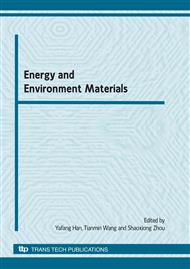p.103
p.109
p.115
p.119
p.126
p.132
p.137
p.142
p.150
Vacancy Phonon Scattering and Thermoelectric Properties in In2Te3–SnTe Compounds
Abstract:
Solid solution formation is a common and effective way to reduce the lattice thermal conductivity for thermoelectric materials because of additional phonon scattering by point defects and grain boundaries. In the present work we prepared In2Te3–SnTe compounds using a mild solidification technique and evaluated their thermoelectric properties in the temperature range from 318705 K. Measurements reveal that the transport properties are strongly dependent on the chemical composition In2Te3 content, and lattice thermal conductivity significantly reduces above a minimum In2Te3 concentration, which can possibly be explained by an introduction of the vacancy on the indium sublattice and periodical vacancy planes. The highest thermoelectric figure of merit ZT of 0.19 can be achieved at 705 K, and a big improvement of In2Te3 based alloys would be expected if a proper optimization to the chemical compositions and structures were made.
Info:
Periodical:
Pages:
126-131
Citation:
Online since:
May 2010
Authors:
Price:
Сopyright:
© 2010 Trans Tech Publications Ltd. All Rights Reserved
Share:
Citation:


